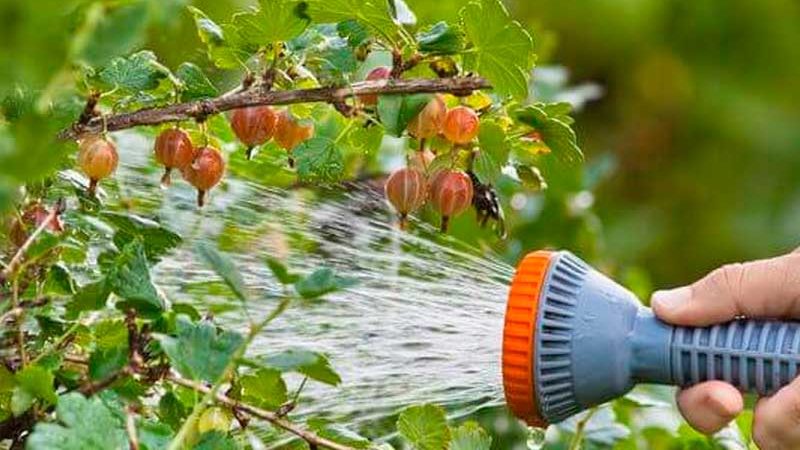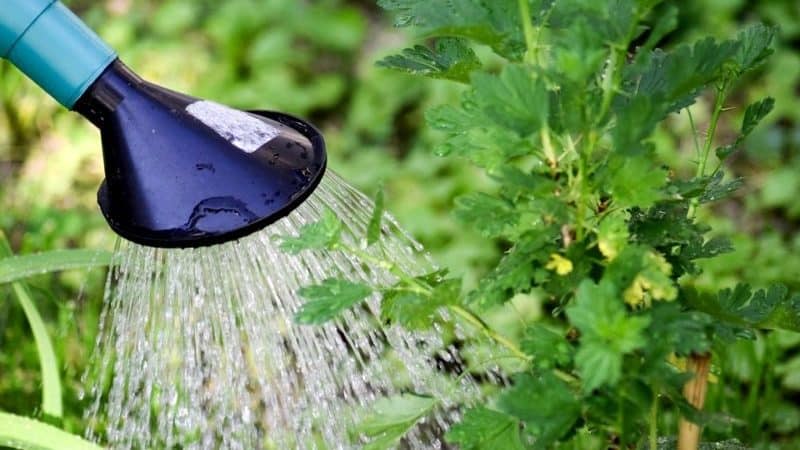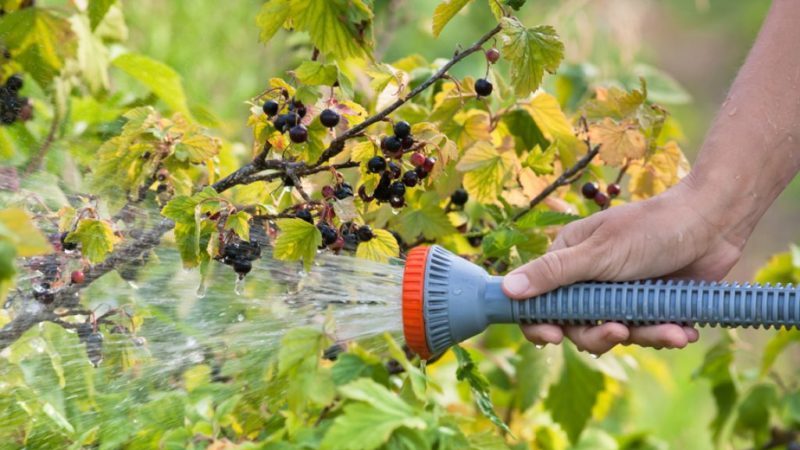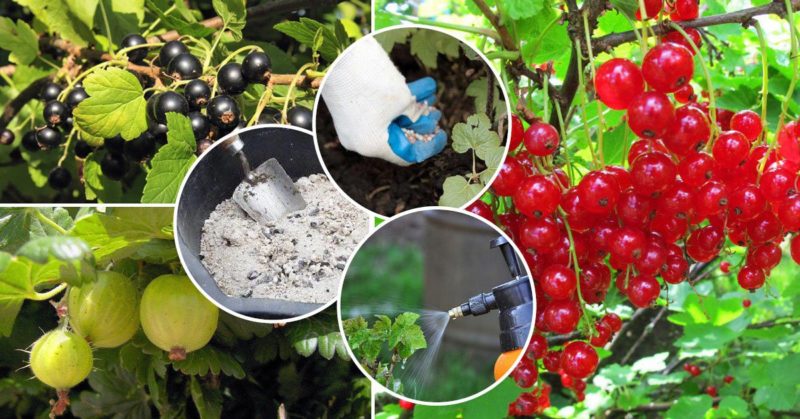How much and how often to water gooseberries and currants in summer
Watering is a mandatory step in caring for berry bushes, including currants and gooseberries. The activity of vegetation processes, ripening, quantity and quality of the harvest depend on it. It is important to follow the norms and timing of summer watering of currants and gooseberries, since both a lack of moisture and its excessive volume can harm these crops.
How often to water gooseberries and currants in summer

The timing and rules for watering currants and gooseberries are almost the same. Both crops are characterized by abundant growth and fruiting with sufficient soil moisture.
Important! Overmoistening threatens the development of fungal diseases, rotting of roots, and falling leaves and ovaries. Therefore, the established norms and frequency of the procedure should not be exceeded.
The frequency and volume of watering is determined based on:
- weather conditions;
- stage of plant development;
- type and condition of the soil.
Abundance of watering
Both crops are moisture-loving and require, although not frequent, abundant watering.. The soil in the tree trunk area is moistened 40-50 cm deep. The average watering rate is 3-4 buckets of water for each bush. When determining the volume, the composition of the soil is taken into account. If the soil is sandy or sandy loam, the norm increases to 5 buckets per 1 square meter. m.
To calculate the volume of water, gardeners recommend using the following method:
- Loosen the soil to check its dryness.
- If the soil has dried to a depth of more than 15 cm, the volume of watering is 40 liters of water.
- In the absence of moisture at a depth of up to 10 cm, 20 liters of liquid is sufficient.
- If the soil is dry only to 5 cm, no watering is required.
The volume of water also depends on the power and extent of the root system and the age of the crop. For young (one-year-old) bushes, you should not exceed the seasonal norm of 50 l, for mature (3-5 years) - 80 l, for old crops (15-20 years) - 120-150 l.
How to water correctly
Berry crops are watered abundantly, the water is directed to the root system. Spraying of above-ground plantings is allowed.
Reference. After watering, it is recommended to lay mulch in the tree trunk circle from available natural materials: peat, compost, sawdust, hay.
Mulch retains soil moisture and looseness for a long time and prevents rapid evaporation of liquid. At the same time, the air circulation necessary for the roots of the plant is not disrupted. During dry periods, it is advisable to loosen the soil between the rows. This will prevent the formation of an earthen crust and reduce moisture evaporation.
When carrying out the procedure, the type of soil is taken into account. Heavy clay and loamy soils require rare but plentiful moisture; sandy soils are best watered in a smaller volume, but more often.

When to water
Berry bushes are moistened in the morning or evening (before sunset), since water evaporation occurs more slowly at this time. During the day, water only in cloudy weather.
Over the entire gardening season, currants and gooseberries are moistened about 4 times:
- At the end of May - beginning of June - when the ovaries are forming.
- At the end of June - during the filling of berries.
- After harvesting - produced mainly for currants.
- At the end of September - early November - in preparation for wintering.
When determining the time of watering, you must first rely on the stage of plant development.The first 2 stages of moistening are the same for both shrubs. After picking the berries, water only the currants. The last water-replenishing moistening is required for both crops. In this case, it is important to do it before frost.
Reference. If precipitation occurs during the planned moistening period, the bushes are not watered.
It is important to monitor the condition of the soil so as not to miss watering time. Crops tolerate drought well, but their vegetation processes slow down, yield and fruit size decrease.
Excessive watering also poses a danger to the root system of bushes and can provoke its destruction and death of the plant. Active hydration is recommended only at the end of May - beginning of June, until the berries are first soft. Then its multiplicity is reduced.
Water requirements
To water shrubs, it is recommended to use good quality water, such as spring water. It should be warm and settled.
Gardeners do not recommend moistening currants and gooseberries with cold water. It is desirable that its temperature be in the range from room temperature to +60°C. This stimulates plant development and protects against diseases.
Read also:
Easy-to-care gooseberry variety “Yarovaya”
Features of watering shrubs in the heat

Since drought inhibits the development and fruiting of plants, in the heat the frequency and volume of moisture are increased. This is especially true during the growing season, flowering, appearance of ovaries and berries, i.e. the first half of summer.
Watering is carried out as the soil dries, approximately once every 1-2 weeks. The volume of liquid is 30-50 liters per bush.If the soil is very hot, the water can not be settled, but supplied directly from the source.
Attention! To keep the soil moist longer in the heat, grooves are made around the bush at a distance of 20-25 cm and filled with water.
Watering methods

Moisturizing currants and gooseberries is carried out in several ways:
- Drip – water is supplied through special irrigation lines located up to 0.5 m from the crop. Low irrigation speed allows the water not to settle, since it has time to heat up under natural conditions.
- Irrigation irrigation - A ditch is formed around the bush from an embankment of soil or using a depression. It is filled with water.
- Watering at the root – standard method, carried out 3-4 times per season.
- Sprinkling - a recommended watering method for currants that does not require labor from the gardener. However, excessive moisture on gooseberry leaves can cause them to burn when exposed to the sun and the development of diseases.
- Influx – water is supplied from a hose located on the ground. In this case, liquid spillage and uniformity of moistening should be monitored. The position of the hose is changed periodically. This creates a risk of overcooling the currant roots, which are sensitive to water temperature.
Do I need to water the bushes during fruiting and ripening?
If there is a lack of moisture during the period of flowering and ripening of berries, crop yields are significantly reduced. This is especially true for black currants - drought leads to a reduction in fruiting not only in the current season, but also in the next year.
Important! Crops must be watered before flowering, during it and during the ripening period of the berries.
Soil moisture is required at the end of May - beginning of June and at the end of June - early July.A good charge of moisture during this period increases productivity and improves the quality of berries.
What to water besides water
In addition to standard moisturizing, an important stage in caring for shrubs is feeding them. For the first time, fertilizers are applied when planting a plant - humus, superphosphate, and ash are placed in the pit.
In June, when crops are actively developing, it is especially important to feed them. For this purpose, nitrogen fertilizers, manure, humus, and compost are used. Fertilizing is combined with watering - it is done before and after the introduction of nutrients.
Fertilizing scheme

If the pits were well fertilized when planting crops, fertilizing may not be necessary for the first 2 years. Regular moistening of the bushes is sufficient.
Next, fertilizers are applied in stages:
- in spring (in May) mineral fertilizing is required. To do this, dissolve 10 g of nitrogen, 15 g of potassium, 20 g of phosphorus fertilizers in 10 liters of water. This dosage is designed for 1 bush.
- In June fertilizing helps the growth of shoots and the filling of fruits after flowering. The procedure is combined with watering. Mullein diluted in water in a ratio of 1:4 is introduced into the soil. Dosage – 1 bucket per 1 bush.
- After fruiting the soil and bushes also need to be prepared for the next season. Fertilizers are introduced for digging (per 1 sq. m): organic - up to 6 g, phosphorus - 30 g, potassium - 20 g.
To prepare for winter, manure and compost are added to the soil, combined in a 1:1 ratio. This fertilizing increases the frost resistance of crops.
Watering shrubs in spring
In early spring (March), gardeners recommend watering currants and gooseberries with very hot water (+80°C). This treatment effectively neutralizes pathogenic organisms overwintering on shrubs or in the soil, prevents the formation of fungal colonies, and activates vegetative processes in plants.
Important! Shrubs should be watered with boiling water until the buds awaken.
To retain moisture, the tree trunk circle is sprinkled with peat, sawdust, and humus. In the spring-summer period (late May - early June), plants are watered as standard - with warm, settled water.
Advice from experienced gardeners
To obtain a bountiful harvest and maintain the health of crops, it is important to follow the rules for caring for them:
- A few days before the planned humidification, water is collected in barrels. So it will heat up and settle.
- Before the procedure, the old layer of mulch is removed, the area near the trunk is weeded, otherwise watering will accelerate the growth of weeds.
- Recommended moisturizing time is the evening before sunset. During the night, the roots are completely saturated with moisture.
- Plants should not be watered during the day, especially when exposed to sunlight. This will cause a burn. During the day, watering is allowed only in cloudy weather.
- After moistening the soil, it is advisable to immediately apply fertilizing.
- During hot summers, it is necessary to regularly check the degree of dryness of the soil. Increase the frequency of watering.
- Crops especially require moisture during flowering, ripening, and fruiting. Drought should not be allowed at this time.
- Excessive moisture is harmful to shrubs. This causes root rot, decreased yield, and the development of diseases. Gardeners believe that excess moisture is more dangerous than drought for currants and gooseberries.
Read also:
Conclusion
When watering berry bushes, it is important to maintain the water balance of the soil. Over the entire season, crops are moistened 3-4 times; in hot summers, the multiplicity can be increased. Active watering during plant development, flowering, and fruiting improves the yield, quality and taste of berries. For optimal life of shrubs, it is also necessary to regularly feed them with fertilizers.